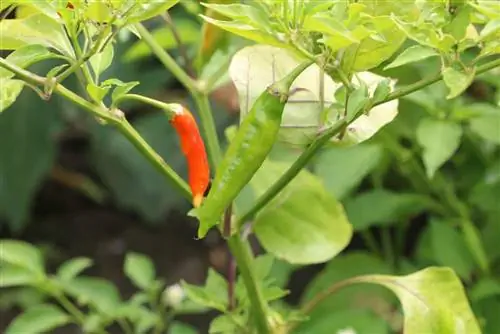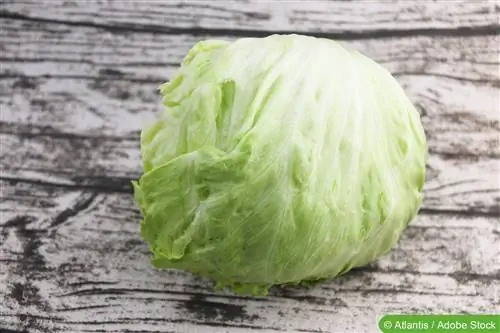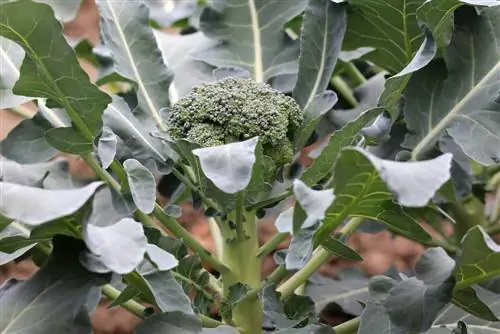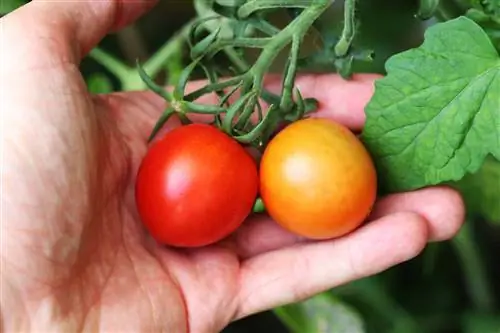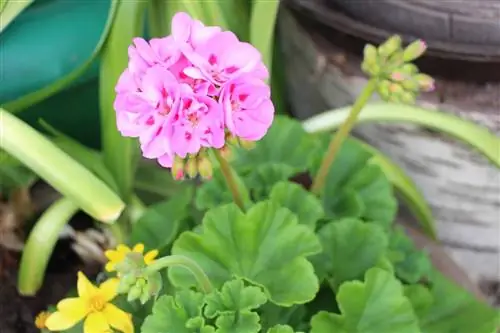- Author admin [email protected].
- Public 2023-12-17 03:39.
- Last modified 2025-01-24 12:45.
Seedless chili varieties contain many seeds, which are usually removed during preparation. You should keep a few of them. Every single one of them can transform into a green, richly bearing plant the following year. But there are also promising seeds on the market. Starting with sowing, the gardener has to do a few things so that the open ground can be conquered quickly in May.
F1 Hybrids
The first question when growing chili is not just about the right variety so that the flesh and level of spiciness correspond to your own preferences. The decision as to whether it should be “real” seeds or F1 hybrids is also a fundamental one.
- Almost only F1 hybrids are now available in stores
- Above all, they promise high yields
The seeds of the harvested chili peppers are not of the same variety, much to the delight of the agricultural industry. Seeds must be purchased every year to reproduce. Apart from the fact that only worthwhile varieties find a permanent place on the market.
“Real” seeds
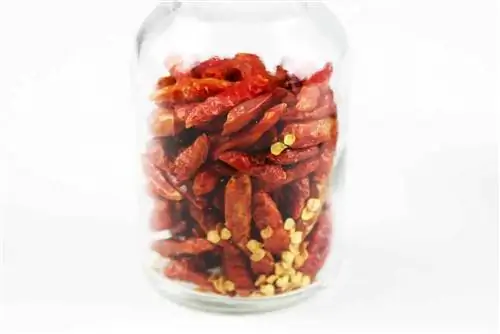
If you want to preserve nature's biodiversity and also grow unusual, old chili varieties, you will find them in special online shops or at seed banks. You can get seeds from the later harvest at any time for further propagation, completely free of charge. The agricultural industry argues that the F1 varieties have a higher yield, but are they still as full of valuable ingredients as the true-seed varieties? And do we want to encourage this dependency?
Quantity required
Seeds you collect yourself are free and theoretically available in abundance, but purchased seeds are portioned and expensive. Before sowing, the question arises, how many seeds are necessary?
- the size of the available bed area decides
- calculate a radius of 30 to 40 cm per chili plant
- plan a reserve as not all seeds will germinate
Tip:
Purchased packets contain 20 to 100 seeds, although they do not need to be sown all at once. Their germination capacity is usually 3-4 years.
Saving seeds
The seeds must be stored properly until they are sown so that their quality does not suffer. Best kept well closed, cool, dry and dark. Seeds that you remove from ripe pods should be dried beforehand.
Germination test
The ability of seeds to germinate decreases over the years. If you are not sure whether the chili seeds are still capable of germinating, you can do a germination test in January.
- moisten a few layers of household paper
- put on a plate
- spread some seeds on it
- Put clear film over it
- poke a few holes in it
- set up warm
Depending on the variety, you will see after two to four weeks how many seeds have actually germinated. This result can be applied to all seeds. If the germination rate is low, you have to sow more seeds or even get new seeds.
Time for sowing
Chili, botanically Capsicum annuum, requires temperatures above 20 degrees Celsius to germinate. In this country, the seeds can only be sown outdoors from mid-May because only then is there no longer any threat of frost. Unfortunately there is only one problem: the long time until harvest.
- Most chili varieties take a long time to reach maturity
- about 90 days after sowing
- some varieties even 120 days
If you do the math carefully, you will quickly realize that the harvest does not begin until August or September. This is far too late, especially since the season cannot last much longer due to the climate.
If you want to harvest earlier and for longer, you should not sow the chili seeds directly in the bed, but instead send young chili plants to start in May. The seeds must first germinate in a suitable room.
- start sowing in February
- in March at the latest
Tip:
For everyone who doesn't have the time or opportunity to sow early: There are some types of chili that are ready to harvest after just 50 to 70 days. Ask your specialist retailer about this.
growing soil
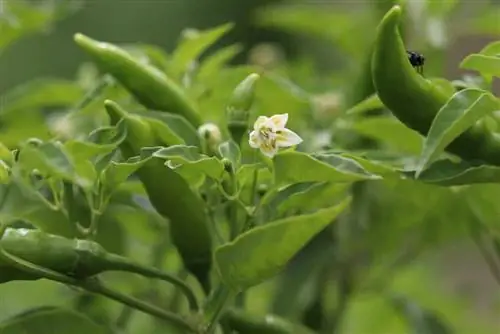
The easiest way is to buy potting soil from specialist retailers that is low in nutrients and largely free of harmful germs. But chilies also germinate in normal garden soil. You can sterilize these beforehand in the oven at 200 degrees for 30 minutes so that all harmful germs are killed.
Growing pots
When it comes to early sowing of seeds, the trade has a lot to offer. Special cultivation pots, multi-pot plates or small, heatable indoor greenhouses are included. They certainly have their advantages, but they are not a must. Chili seeds also germinate in “old” pots. It doesn't matter whether they are empty yogurt cups, old flower pots or other bowls. You just need to meet the following requirements:
- be big enough
- with holes
- be washed clean
You can use several small pots of around 10 cm in which you can sow 5-6 seeds each, or you can use a larger container that offers enough space for all the seeds.
Tip:
If you sow different varieties, you should use a separate pot for each variety so that you know exactly which plant you are holding in your hand when planting later.
Sowing instructions
- Place the seeds in warm water for a few hours, where they can swell. Use separate containers for different varieties so that the seeds are not mixed.
- Fill the cultivation pots with soil, leaving only about 2 cm free.
- Water the soil until it is completely moistened.
- Spread the seeds on top. The distance between individual seeds should be about 2 cm.
- Cover the seeds with a layer of soil about 5 mm thick.
- Moisten the top layer of soil with lukewarm water. It is best to use a spray bottle to prevent the seeds from being washed out of position.
- Cover the pots with cling film so that the soil does not dry out.
Location
Place the cultivation pots in a bright and warm place. A window seat above the heater is ideal. The temperature should be above 20 degrees. The higher the temperature, the faster the seeds germinate. At 30 degrees Celsius the germination time is around 8-14 days.
Care
Keep an eye on the sowing so that the seeds develop into strong plants. The soil should remain slightly moist throughout. When waterlogged, mold can spread quickly. Ventilate the cover once a day until the seeds have germinated, after which it can be removed completely.
Pricking
About four weeks after sowing, the chili seedlings will have formed their first leaves, then it is time to prick them out. If you wait too long, the plants will grow taller to get more light. The stems remain thin and weak.
Material for pricking
To prick chilies you need:
- small pots about 10 cm in diameter
- made of plastic, clay or another material
- fresh potting soil
- Pickerstab
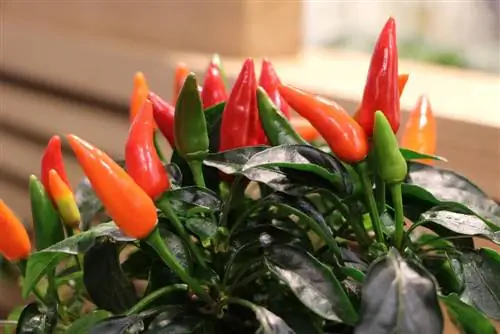
The pricking rod is helpful for separating the plants from each other and removing them from the seed tray without damage. A spoon handle also serves the same purpose.
Tip:
You can make inexpensive potting soil yourself by mixing garden soil from deeper layers, medium-grain sand and mature compost.
Procedure
- Moisten the soil in the seed tray because this will make it easier for the chili plants to separate from each other.
- Fill all pots with potting soil, leaving 1 cm free.
- Prick a 3-4 cm deep hole in the middle with the pricking rod, into which the seedling will later go.
- Select those that have developed best from all the seedlings.
- Prick the seedling with the pricking rod and carefully pry it out of the soil. If possible, there should be as many roots as possible.
- Insert the seedling into the prepared planting hole up to the cotyledons. The roots should not bend to the side.
- Prick out as many seedling as you need one after the other.
- Press the soil and water carefully.
- Place all pots in a bright location that will not be exposed to direct sunlight in the next few days.
Care for young plants
The pricked plants need a lot of light, high humidity and warmth around 20 to 22 degrees. If they cannot stand very brightly, the ambient temperature should also be cooler, otherwise they will rot. Start applying fertilizer after two weeks and gradually accustom the plants to the fresh air.
Note:
If the plants are growing very strongly, it may be necessary to transplant them a second time into larger pots.
Planting out
After the Ice Saints, the chili plants are finally allowed outside permanently. Don't let warm days tempt you to plant them out earlier. At night the temperature can drop below 0 degrees and destroy the plants. Cold temperatures can also inhibit growth, so that the plants only develop further with a delay. A chili plant does not necessarily have to grow in a bed. Large containers are also ideal for these vegetables.

